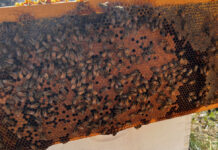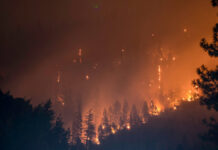Now that the last frost date is behind us, our gardening activities have stepped up a notch. For example, the tomatoes and peppers are on the deck hardening off.
While in town the other day, we bought mulch, compost, pots for the container garden, and checked out plants, from herbs to bushes, including annuals and perennials for the pollinator garden. We’re getting to know the folks at the general store, where we go for our soil amendments, garden supplies, and chicken feed, so it’s nice to see them and chat for a few minutes.
We also ate our first post-mask mandate lunch. As soon as we walked in, we noted that the restaurant had added a chunk of its tables back to what had been a sparsely populated room just a few weeks ago. I would guess they were somewhere close to 75 percent of their “normal” tables present, a big increase. About half the wait staff were wearing masks and about half were not.
That afternoon, we went to a farmer’s market to pick up a few things, from greens to fresh eggs and baked goods. It was an eclectic bunch of folks manning the booths, and because it was not terribly busy, everyone was quite talkative. We met a fellow who raises different kinds of mushrooms and a couple of young women who have started a new farm and are working on farm-to-table programs with local restaurants. We’re hoping to plan a farm visit for July.
Snakes and Critters
Back at home, I spotted a large black snake while I was working on the chicken coop. I’m talking 4-1/2 to 5-feet long, and bigger around than my wrist. It’s obviously lived here longer than I have. No idea where it popped up from, but when the snake saw us, it hid behind the HVAC unit. I tried to get a picture from the other side, but the snake wanted none of that and did a quick U-turn before disappearing under the porch.
I hope it cuts down the mice population.
Black snakes are on my approved list, at least until they start eating chicken eggs. Our chicken coop should be snake-proof, but you never really know how good your security system is until you test it in a real-world situation.
We are in the range for rattlesnakes and copperheads. That’s why the first round of both my gun and my wife’s are filled with snake-shot. And let me tell you, that load of .38Spl snake shot is potent! After seeing its effect on a cardboard target, I would not want to get hit in the face with a blast of that stuff. I have no doubt it can bring a quick end to a snake. The .22 snake shot is not as powerful, but should still do the job. A friend of mine has killed dozens of rats with it.
When are Weeds Good
One man’s wild flower may be another person’s weed. It just depends on where it is planted. My wife, the master gardener, defines a weed as any plant growing where you don’t want it to grow. That means a very beneficial plant can be considered a weed if it is in the wrong place. Right now, we are working to turn what was once a lawn into a meadow, and anyone with a perfect lawn would probably consider ours to be full of weeds. We see it as full of pollinators for the bees.
My wife hates invasive plants, and after seeing how something like periwinkle can take over the surrounding area decades after being planted as ground cover is enough to convince me that invasives are a problem. They can force out natural plants, thereby reducing the habitat for native birds, rodents and other animals. We are eradicating invasive plants found on our property where we can, especially those known to spread rapidly or aggressively. This can mean digging, chopping, hoeing, pulling, or spraying with herbicide.
Plants that spread by rhizome, meaning underground, can be especially difficult to eradicate. It can take years of repeatedly killing off the shoots before the rhizome finally lacks enough energy to sprout again. Depending on the plant, this is one of the times when my wife whips out the spray bottle of Round Up.
Stocking Up Round Up
Let me state two things for the record: We are not organic gardeners and have never claimed to be, nor do we believe all the negative press and court cases claiming the active ingredient Round Up causes cancer.
When my wife heard that Bayer, which bought Round Up from Monsanto a few years back, might decide to stop consumer sales of the herbicide, she decided we better stock up. Now we have three bottles of the concentrate, and I expect that number will grow.
Do we use Round Up in our garden or in raised beds? No. Do we use it to kill of grass in the driveway, unwelcome plants growing where we don’t want them, and to help ensure trees and saplings we cut down don’t generate a bunch of suckers? Yes we do. Do we follow label directions, and are we careful to keep it out of waterways? Of course. Are we planning to stop using it? No way.
Prepper Gardens
Here’s how I look at prepping and organic gardening: Organic gardening is a worthy pursuit, but it also more difficult than chemical-assisted gardening and can result in lower production and even crop losses. There may come a time where every ounce of food we can produce is needed to keep our prepper family fed. When that time comes, our concern is going to be pumping up production. Whether nor not the harvest can be considered organic is not going to matter after the SHTF or when food prices are so high you can’t afford to buy fresh produce.
Will we be making our own compost? Of course. Will our chicken manure eventually end up fertilizing our plants? Yes indeed. Will we strive to use organic matter to create healthy soil that includes a living biome? You bet. But if we have to treat some fungi with a non-organic treatment in order to save our crop of squash, then we’ll probably do it, after checking to make sure it isn’t harmful to honey bees, of course.







